
The 120s was a decade that ran from January 1, AD 120, to December 31, AD 129.
The 580s decade ran from January 1, 580, to December 31, 589.
The 170s decade ran from January 1, 170, to December 31, 179.
The 270s decade ran from January 1, 270, to December 31, 279.
Year 165 (CLXV) was a common year starting on Monday of the Julian calendar. At the time, it was known as the Year of the Consulship of Orfitus and Pudens. The denomination 165 for this year has been used since the early medieval period, when the Anno Domini calendar era became the prevalent method in Europe for naming years.
The 350s decade ran from January 1, 350, to December 31, 359.
The 370s decade ran from January 1, 370, to December 31, 379.
Year 356 (CCCLVI) was a leap year starting on Monday of the Julian calendar. At the time, it was known as the Year of the Consulship of Constantius and Iulianus. The denomination 356 for this year has been used since the early medieval period, when the Anno Domini calendar era became the prevalent method in Europe for naming years.
The 210s decade ran from January 1, 210, to December 31, 219.
The 260s decade ran from January 1, 260, to December 31, 269.
The 280's decade ran from January 1, 280, to December 31, 289.

Aurelian was a Roman emperor who reigned from 270 to 275 during the Crisis of the Third Century. As emperor, he won an unprecedented series of military victories which reunited the Roman Empire after it had nearly disintegrated under the pressure of barbarian invasions and internal revolts. Born in modest circumstances, most likely in Moesia Superior, he entered the Roman army in 235 and climbed up the ranks. He went on to lead the cavalry of the emperor Gallienus, until Gallienus' assassination in 268. Following that, Claudius Gothicus became emperor until his own death in 270. Claudius' brother Quintillus then ruled for three months, before Aurelian took the empire for himself.

Year 269 (CCLXIX) was a common year starting on Friday of the Julian calendar. At the time, it was known as the Year of the Consulship of Claudius and Paternus. The denomination 269 for this year has been used since the early medieval period, when the Anno Domini calendar era became the prevalent method in Europe for naming years.
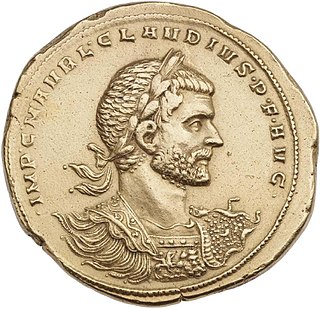
Marcus Aurelius Claudius "Gothicus", also known as Claudius II, was Roman emperor from 268 to 270. During his reign he fought successfully against the Alemanni and decisively defeated the Goths at the Battle of Naissus. He died after succumbing to a "pestilence", possibly the Plague of Cyprian that had ravaged the provinces of the Empire.
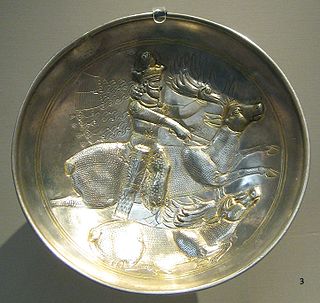
Year 371 (CCCLXXI) was a common year starting on Saturday of the Julian calendar. At the time, it was known as the Year of the Consulship of Augustus and Petronius. The denomination 371 for this year has been used since the early medieval period, when the Anno Domini calendar era became the prevalent method in Europe for naming years.
Year 214 (CCXIV) was a common year starting on Saturday of the Julian calendar. At the time, it was known as the Year of the Consulship of Messalla and Suetrius. The denomination 214 for this year has been used since the early medieval period, when the Anno Domini calendar era became the prevalent method in Europe for naming years.
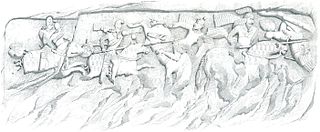
Year 224 (CCXXIV) was a leap year starting on Thursday of the Julian calendar. At the time, it was known as the Year of the Consulship of Iulianus and Crispinus. The denomination 224 for this year has been used since the early medieval period, when the Anno Domini calendar era became the prevalent method in Europe for naming years.
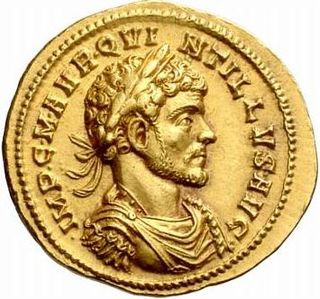
Marcus Aurelius Claudius Quintillus was a short-lived Roman emperor. He took power after the death of his brother, Emperor Claudius Gothicus, in 270 CE. After reigning for a few weeks Quintillus was overthrown by Aurelian, who had been proclaimed rival emperor by the legions he commanded. The ancient sources variously report him to have killed himself, to have fallen in battle against Aurelian, or to have been murdered by his own soldiers.
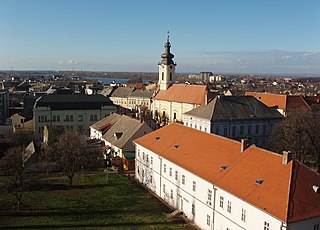
Sremska Mitrovica is a city in Serbia. It is situated on the left bank of the Sava river. As of 2022, the city has a total population of 40,144 inhabitants, while its administrative area has a population of 72,580 inhabitants.

Sirmium was a city in the Roman province of Pannonia, located on the Sava river, on the site of modern Sremska Mitrovica in the Vojvodina autonomous province of Serbia. First mentioned in the 4th century BC and originally inhabited by Illyrians and Celts, it was conquered by the Romans in the 1st century BC and subsequently became the capital of the Roman province of Pannonia Inferior. In 293 AD, Sirmium was proclaimed one of the four capitals of the Roman Empire. It was also the capital of the Praetorian prefecture of Illyricum and of Pannonia Secunda. The site is protected as an archaeological Site of Exceptional Importance. The modern region of Syrmia was named after the city.








